Akita Inus are a fantastic breed with famous loyalty and a very interesting past.
By the end of this article you will have read a comprehensive breakdown of the whole breed from their history to how to get one and everything in between.
All of these factors will help to determine if this is the right dog for you.
IMPORTANT NOTE: Before we begin we should state that these are all generalizations based on research. All dogs are individuals and much of how they act come down to their history, training, socialization, and that dog’s personality. The following information is not a guarantee of how this breed or any individual dog will act.
Table of Contents
History/Origins of the Akita Inu
Ancestors
The Akita Inu dog breed originated in the Akita prefecture (a region in Japan), located in the far north of the country.
This prefecture is known for its harsh winter’s wide abundance of snow, especially during winter.
Because of this, residents of this area needed a dog that could both hunt and survive the harshness of the climate.
This came in the form of a dog called the Matagi Inu which were owned by the Shoguns of Japan.
The harsh weather helped the dog develop a thick coat to protect itself and it was primarily used to track and hunt large animals such as boars, elks, antelopes, and bears.
This generally occurred in the more rural areas of the prefecture, such as the countryside and mountains where large prey was abundant.
The Matagi Inu is regarded as the ancestor of the modern-day Akita Inu dog breed.
During the year 1783, there was a severe famine that claimed the lives of 7,000 people. This resulted in social unrest and enticed residents to prepare for self-defense by wanting a guard dog.
This was done by breeding the Matagi Inu to the point where the Akita Inu came in being. Unlike its predecessor, it was larger in size and more intimidating.
Controversy

During the 1800s, dog fighting became a popular “sport” in Japanese culture. At first, there was a breed called Tosa that was the most popular dog for this.
However, the Akita Inu started being crossbred with muscular and more aggressive dogs so that it could become more competitive in this sport.
As a result of this crossbreeding, the Akita Inu became bigger, more muscular and in some cases lacked upward ears.
As a result, they became different from the original Akitas that were first introduced.
Then in 1910, a “dog tax” was introduced by the Japanese government.
This led to a lot of Akita Inus being killed off so that owners could avoid paying off the tax. Not only that, but there was a rabies outbreak as well, which hit this breed hard.
However, the breed started making a comeback from 1927 onwards where an organization called the Akita Inu Hozonkai (AKIHO) was set up to preserve the breed and forbid any further crossbreeding.
In 1931, the breed was designated as a national monument of Japan.
Pop Culture
Perhaps the most well-known Akita Inu dog was one called Hachiko and is considered the world’s most loyal dog.
Hachiko was a dog owned by a professor called Hidesaburo Ueno. Every day, the dog would follow his owner on his way to work and he would wait patiently for him to come to the same train station as well.
Hachiko would still go to the same station, even after his owner succumbed to cancer. This has been made into two films.
The first called Hachiko Monogatari was released in 1987 in Japan.
In 2009, there was a remake of this called Hachi: A Dog’s Tale. However, instead of the Japanese setting, it has a primarily American setting to it.
Although the latest one has both factual and non-factual elements to it, it resonated well with a global audience and helped to put this dog in the spotlight.
One of the most well-known owners of this dog breed is Russian president Vladimir Putin which goes by the name of Yume. Other owners include Sarah Michelle Gellar and other famous
Hollywood Celebrities
Another famous owner of one of these dogs is a woman named Helen Keller, who in 1938, became the first person to introduce Akita Inus into the United States.
Gifted with two Akita Inus by the Japanese government, this would start the trend of this dog becoming an internationally known dog, similar to the German Shepherd and British Bulldog for example.
American Akita Vs Japanese Akita: The Intense Debate
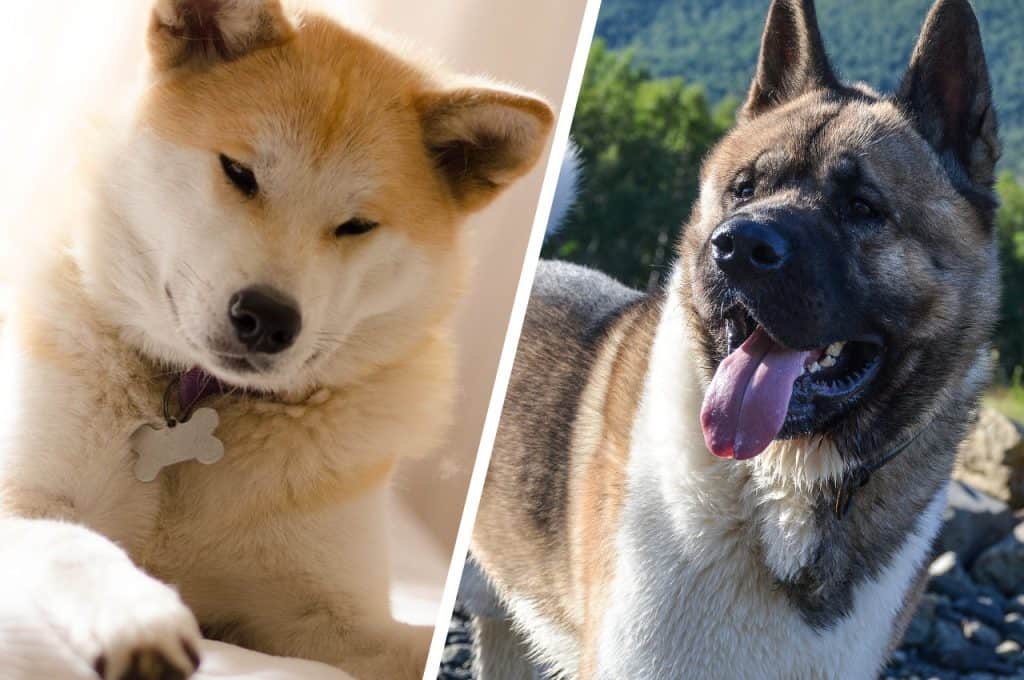
America is actually the only country to recognize the breed as one breed rather than two separate breeds, however, many say that the breed should be split in two.
Which isn’t a bad idea considering how confusing it can be for future dog owners looking for the right dog for them.
Not to mention, the Japanese Akitas are also often confused with the very similar-looking Shiba Inu, but that is a whole separate comparison.
Akita Inu is technically the name for the Japanese Akita, whereas, Akita is said to stand for the American Akita.
In this article typically when we say Akita Inu or Akita, we are talking about the breed as a whole, not one version or the other. If we do get into a specific trait of one version of the breed we will mention either Japanese Akita or American Akita.
Fun Fact: The “Inu” in Akita Inu means “dog” in Japanese. Which can also add to the confusion!
So what makes an American Akita (Akita) different from the Japanese Akita (Akita Inu), let’s start with looks.
The American Akita is much more bear-like and bulky than the Japanese Akita which is more fox-like and slim.
Japanese Akitas tend to be 22 3/4 to 27 1/2 inches tall and the American Akita tends to be 24 – 28 inches tall.
You may not think that isn’t too much more tall, and you may be right, however, take a look at the weight difference…
Japanese Akitas tend to be 50 – 85 pounds whereas American Akitas tend to be 80 – 145 pounds!
This heavier frame and more bear-like appearance is because of the split that happened in history.
When Akitas started being bred with other bigger and more aggressive breeds they began the process of bulking up themselves.
Then, when the Americans were introduced to the breed many of them preferred the bigger guard dog version over the slimmer companion version.
This also means that when looking for a “Purebred Akita” you would have to look for a Japanese Akita as technically they are the purebred version of the breed.
Now the next question you might have is, do American and Japanese Akitas act differently?
This is where things can get really confusing as there are many varying opinions.
From the research we have done, they are quite similar in behavior and personality only with slight differences that owners of either version of the breed may claim.
What I have seen many owners of this breed agree on, is that American Akitas tend to be calmer and more patient than their smaller counterpart the Japanese Akita.
Japanese Akitas are said to be more temperamental and “bratty” than the American Akita. This may be able to be attributed to the American Akita being bigger, but I can’t say for sure, hence, the debate.
However, it is uncertain if this can be answered definitively as an individual dog’s temperament and behavior are heavily impacted by their owner and upbringing.
My recommendation is that you do much research and ask any owners of the breed you may know or even in online communities.
In addition to asking any professionals like breeders or veterinarians if you are able to!
Research is always the most important stage especially when getting a breed you are unfamiliar with.
Personality and Behavior
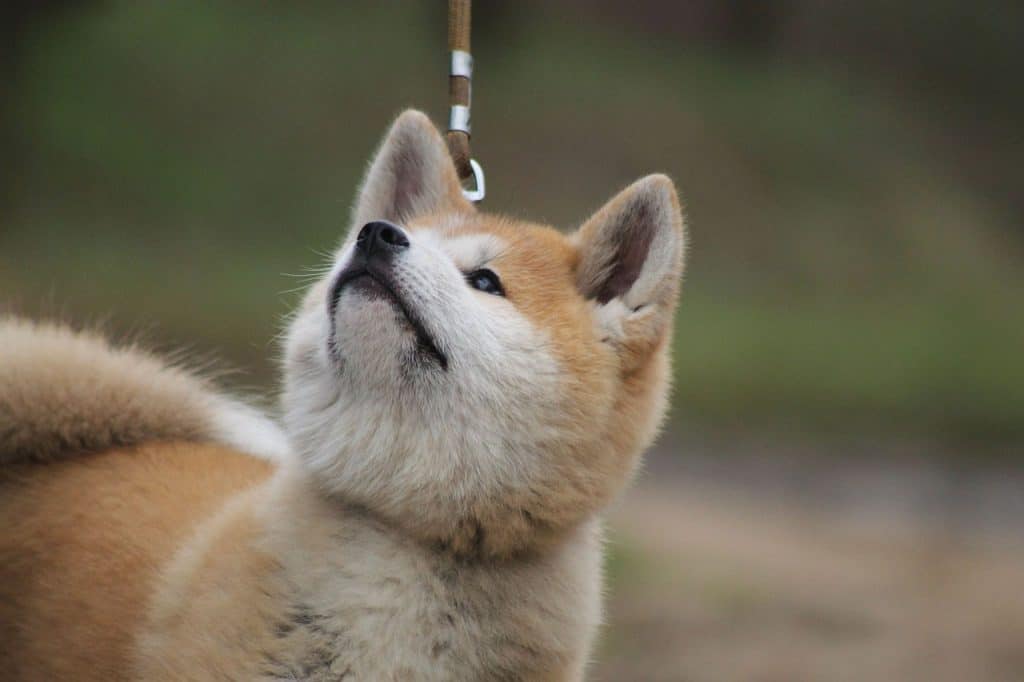
Personality
The Akita Inu is well known for its calm, sensitive, and affectionate personality with those inside their family which makes it popular for experienced dog owners.
However, these dogs are generally warier towards strangers, so it can take time for someone new to build up a relationship with one of these dogs.
Temperament means the dog’s nature and how it affects its behavior in everyday life.
There are several factors I will talk about when discussing its temperament and personality.
Affection
The dog is generally affectionate towards its social group (this would be the owner, kids, cats, etc.) as they would interact with them every day.
However, when it comes to people and animals outside this boundary, they can be wary and cold towards them.
The dog is known for its easy-going, gentle, charming nature, which it displays on a daily basis to its family.
However, strangers of both the human and animal variety can be a different story.
Wary of Strangers
When an Akita comes face to face with a person it has never met before, it will generally keep its distance to analyze them.
In order for someone new to build a successful relationship with one of these dogs, it is generally encouraged to avoid petting them at first.
Independence
The Akita is a very independent dog in how it goes about its business. The only exception is when it’s with its social group.
As a matter of fact, we think that the Akita Inu is one of the best dogs that can be left alone.
Of course, as a puppy the Akita Inu will require much attention and care from their owners. As well as training, socialization, and other things that every puppy needs.
However, once they reach adulthood, this should not be a problem in terms of separation anxiety.
Barking Tendency
Fortunately, the Akita is a breed that is not known to bark often. The funny thing is that they are actually known more to vocal by mumbling, moaning, and grunts.
Often times owners of the Akita will say that this breed is always giving their opinion on something they don’t agree with.
They are known to be less vocal when it comes to attacking, if they feel as if they are in danger or their pack is in danger they will pounce.
Growling or barking beforehand is not something they are known to do. This can prove a challenge to dog owners as often times you won’t know what their feeling until it is too late.
Intelligence
In addition, Akitas are known to be an intelligent dog so they understand commands quickly and may even surprise their owners.
This may come as a surprise to many because of their very quick to aggressive nature, but they are quick learners and can be taught many things.
This makes them easier to train in this regard, however, there are other factors that can make them more difficult dogs to train.
Energy Level
Akitas have plenty of energy to go around especially when they are puppies.
This is why it is especially important that you get your Akita the exercise they need or they can cause you problems.
And the last thing you want is a restless/stressed American Akita that weighs more than 100+ pounds.
As long as you get them outside every day for their required exercise they can actually be very calm, loving and even independent member of your family.
Not Good Dogs For First Time Owners
If you are just starting your dog owner journey then this IS NOT a breed that we recommend. They tend to be quite stubborn, and with their issues when it comes to aggression it will take an experienced owner to train an Akita.
For the newbie to dogs we have a list of the best dogs for first time owners!
The Akita Inu has a tendency to get on with both people and animals in different ways.
So we will break each one down and explain the situation as best as we can.
Behavior
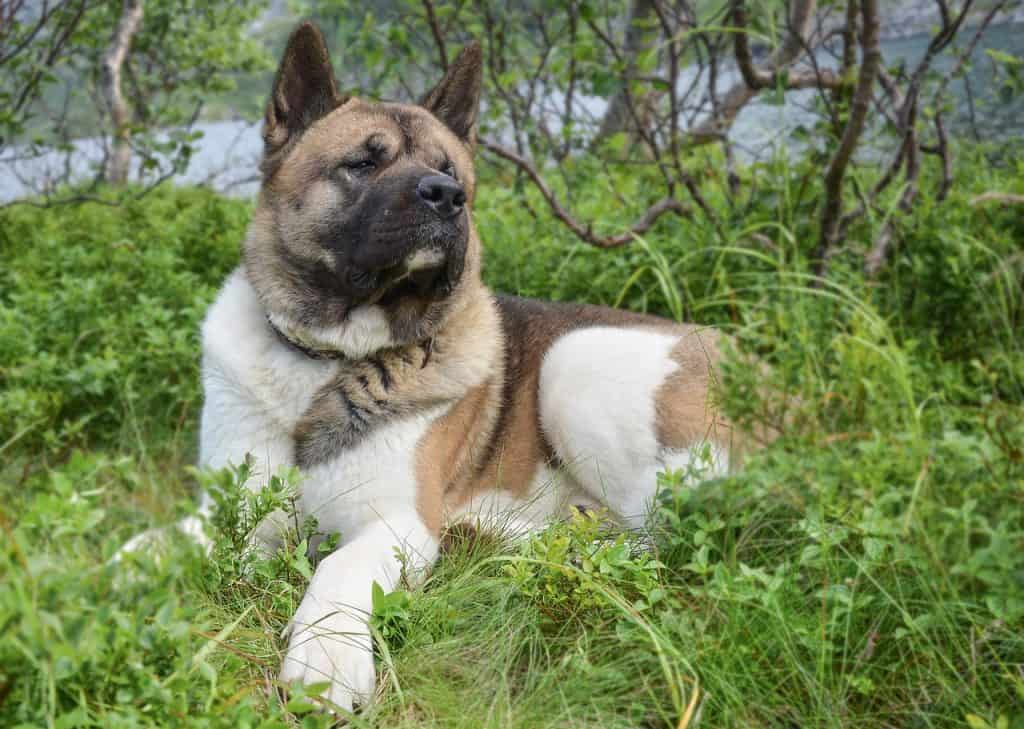
Nipping Tendency
When Akitas start out as puppies, it is quite common for them to nip and bite, especially when they are teething. However, they can be trained to break this habit while they are still young.
Don’t allow this to go on for long or it will be a recurring and destructive habit as they get older. There are some great guides available on how to stop nipping during those puppy years.
Are Akita Inus Good Guard Dogs?
Akita Inus are considered to be an excellent choice for use as a guard dog. This is to do their territorial instinct and distrust and wariness of strangers.
If you are talking about the American Akita, their size is so impressive that they are naturally better guard dogs. After all, some of them can weigh over 100 pounds!
This aggression or suspicion is typically towards outsiders, meaning they don’t know or consider not to be family.
This dog will strive to protect anyone within its own social group from potential threats. In addition, to knowing how to show their social group love and kindness when they are in a familiar environment.
Akita Inus are considered attached and loyal to their social group. Which is why we often stress that early socialization with all member of the family is key.
You want your Akita to know everyone that is going to spend a lot of time in their home so they know not to be aggressive or suspicious of them.
Their loyalty to their family also makes them unlikely to attempt to run away and explore outside of the home.
Mouthing Tendency
This is a more adorable and less harmful behavior that Akitas have. Basically, this means they have a tendency to carry things in their mouth often.
Things like toys, bones or whatever else they can get their hands on they will put it in their mouth to show that they love it.
Sometimes they will even try to put your hand in their mouth, not as aggression but as an act of love!
Often times they will use this to communicate as well. Some things they might communicate with is: bringing you the leash to show they want to walk, or bringing you a toy to show you they want to play.
You will undoubtedly be very impressed at what these sharp dogs will learn to do in order to communicate with you without speaking (or barking).
How Do Akita Inus Get On With Others?
Are Akita Inus Good With Cats?
No, but it is possible for Akitas and cats to have a harmonious relationship with each other. However, for this to happen, they must be socialized at a young age.
Even if this were to happen, there will still be times where they will not get on with each other.
Also, Akita Inus have an extremely high prey drive that won’t help the situation.
If you can avoid the two living together, that is most likely the best option.
Are Akita Inus Good With Kids?
Yes, but Akitas are only good with older children. If you have younger children then DON’T get an Akita.
Akitas are known to be great, loyal companions to the family, however, accidental wrongdoings by a younger child may be seen as a threat to the Akita.
This stems back to them being guard dogs and that will not end well with young children present.
Are Akita Inus Good With Other Dogs?
Probably the least effective relationship with the Akita, is its relationship with other dogs.
This is mostly to do with the Akita Inus demeanor which other dogs see as threatening.
To add to this difficulty is the Akita’s predatory instinct, carried over from its dog fighting days.
As a result, it can be difficult for Akita Inus and any other breed to get along with each other.
Are Akita Inus Good With Rabbits and Other Small Animals?
Rabbits and other small animals can be a risk around Akita Inus, so it’s best to socialize them young or avoid the situation.
Akitas may display aggression towards other animals as they have a high prey drive and in the past have been used for hunting which breeds this instinct into them.
Are Akita Inus Good For Young Couples?
Yes, Akita Inus can be a perfect choice for couples in their 20’s.
Partners can each get a chance to bond with the dog and these dogs can provide excitement and responsibility in their lives.
For fit couples especially, this dog is great for taking along with you on a run or jog.
Are Akita Inus Good For Seniors?
No, this dog is generally not recommended for elderly owners.
The Akita Inu’s high-energetic mood means that elderly owners will find this dog harder to look after, especially if these owners are in a fragile state themselves.
Physical Characteristics
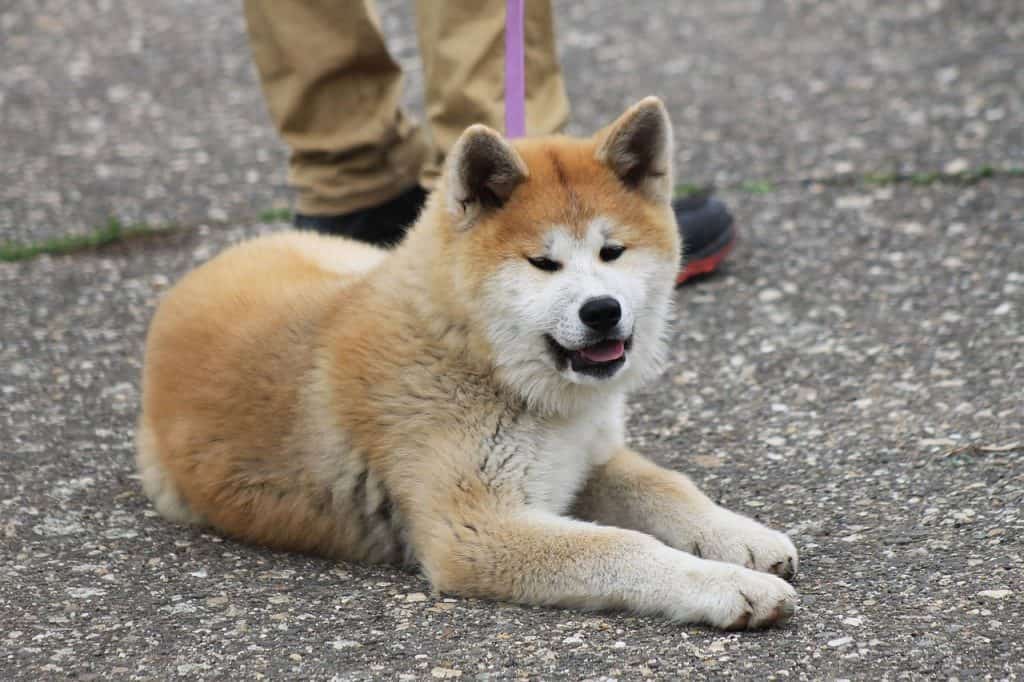
The Akita has several physical characteristics which make it stand out. But first let’s talk about some standard physical traits.
- The Akita Inu’s coat is double-layered which ranges in size from short to mid-length.
- The Akita Inu’s one and only eye color is brown.
- There is a decent range of colors an Akita Inu can be. This breed’s coat colors include fawn, sesame, pinto, brindle, red and white.
A dog’s physical characteristics is determined by the genes it inherits from its mother and father.
Each dog carries two copies of every gene, which are inherited from both parents.
Usually, it is the difference in how the protein is produced, which determines the dog’s own unique physical characteristics.
As far as shedding goes, Akita Inus have annual shedding periods and are VERY heavy shedders. Most notably, during Spring and Autumn.
Fun Fact: Akitas have webbed feet, which can help them swim. However, it was actually developed to help them walk on snow!
Akita Inu Lifespan
The average lifespan of a Japanese Akita is 11 – 15 years.
The average lifespan of an American Akita is 10 – 12 years.
Climate Suitability
Here, I will discuss both hot and cold climates and how the Akita Inu adapts to both.
Hot/Tropical Climate
The Akita can deal with hot or tropical weather.
However, in terms of resting or relaxing, they will always prefer to stay in a cool place when not in direct contact with heat.
They were bred in a cold place so their physical traits are all developed to deal with colder temperatures which can prove to be a problem when this dog is in hot climates.
Akitas have a chance of overheating if they stay in the warm weather to long, so it is best to keep that in mind.
Cold/Temperate Climate
Akita Inus are known to do well in cold and snowy places as that is the climate that they were originally bred for.
The dog’s thick coat helps to protect it from the cold and snow. This has also made them ideal for search and rescue missions and the likes in colder climates.
Best Places For An Akita Inu To Live
Here, I will discuss the type of housing structures the Akita is most suited for.
Houses
The average house in the suburbs or countryside that has a good-sized yard is perfect for Akita Inus. This is the best situation for Akita Inus overall as they get everything they need and just the right amount to be happy.
Large housing space and easy access to nature and parks make it a great place for Akita Inus to live because they can get the daily exercise they need to stay happy.
Are Akita Inus Good Apartment Dogs?
Yes, Akita Inus can be great apartment dogs as they are very independent adults and if you supply them with enough outdoor time every day they will be just fine.
So if your apartment isn’t close to any park or green area where you can walk your dog around for their exercise it isn’t recommended that you get an Akita Inu.
An Akita Inu that doesn’t get the exercise they require could easily end up being stressed out and have other behavior issues.
It should also be noted that you should have a good-sized apartment as an Akita Inu will still need plenty of space to stretch their legs inside.
Townhouses
Same with apartments, as long as you have access to a place where you can walk your Akita Inu every day you should be fine to get them the physical and mental stimulation they need you should be good.
Also, your townhouse should be a good size that a dog could happily scamper around and chase a toy as they will spend plenty of time indoors and should feel comfortable.
Training
How Easy Are Akitas To Train
Training an Akita is known to be a challenge as they can be assertive, strong-willed, and can bore easily.
In addition to being a stubborn dog which often interferes with training.
Nevertheless, it is still possible to train them and to expect top-notch results but it won’t be easy and you need to do it the right way.
It is best to start training them when they are a puppy when they are about 7-8 weeks old.
Also, you need to be respectful of this dog otherwise the training will go very poorly.
It is a two-way street, if you do not respect them and train them with poor methods they will not act respectfully towards you, only extending the time to train them.
For more information on how to train Akitas, check out this article.
Attention and Socialization
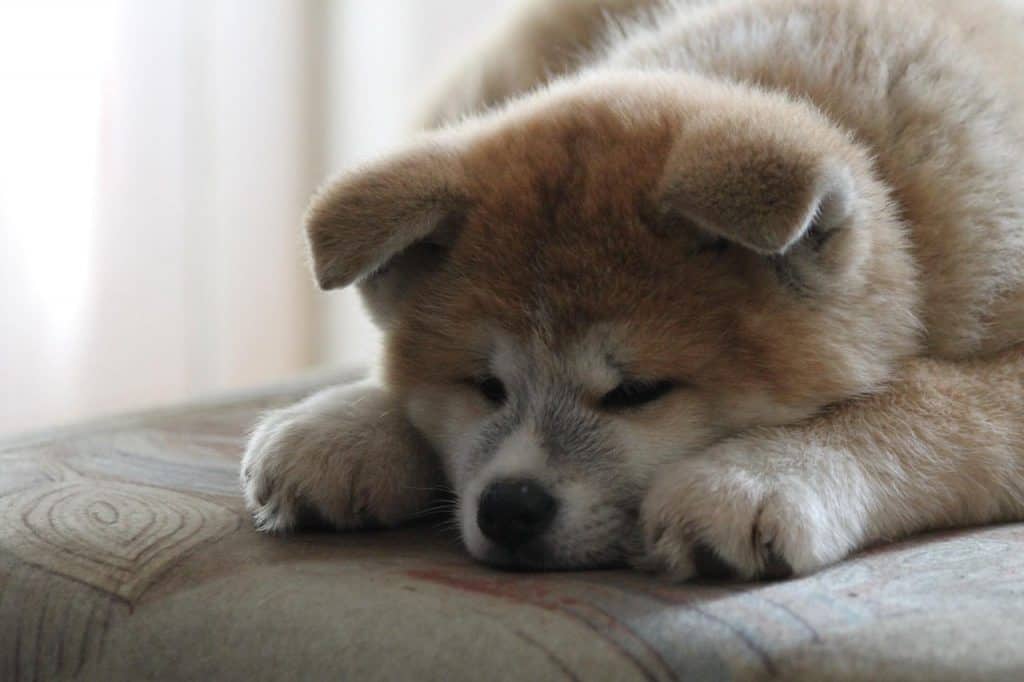
Attention
Akita Inus are like every other dog you will meet. How much attention it needs is hard to answer since each individual dog is different.
There are several factors to discuss regarding giving your dog attention.
We will start with a less common situation, but one that should be talked about for people that are adopting.
If You Adopted An Akita Inu That Was Abandoned
There is a chance that your Akita may have come from a dog shelter.
Usually, in some cases, this is the result of these dogs being left on the street by previous owners.
As a result, your dog may have trust issues with humans because of its previous experience.
In order to build a trusting and effective relationship with your new Akita, it is best to give them lots of attention for the first few weeks or months.
General Behavior
In most Akita cases, they would have brought up in a household without any trauma being inflicted on them.
Usually, when they are puppies, some owners choose to take two weeks off from their job to help them settle into their new environment and to make them feel comfortable.
This helps the puppy to put trust into their owner and to build a new fostering relationship.
But when they are older, it is usually suitable to leave the dog at home alone for periods of time.
However, a suitable schedule must be created. Otherwise, your dog will lose trust in their owner.
DO NOT Spoil Your Akita Inu
It is important to note that owners have a responsibility not to spoil their dogs. It can happen without you knowing or maybe you think you can’t help it, but you can.
You must make sure you don’t overly spoil your Akita or you will train your dog to be overly demanding. As a result, this can create a major burden for you.
The amount of time you spend with your dog should be balanced with the amount of time the dog spends with itself occupied.
Socialization
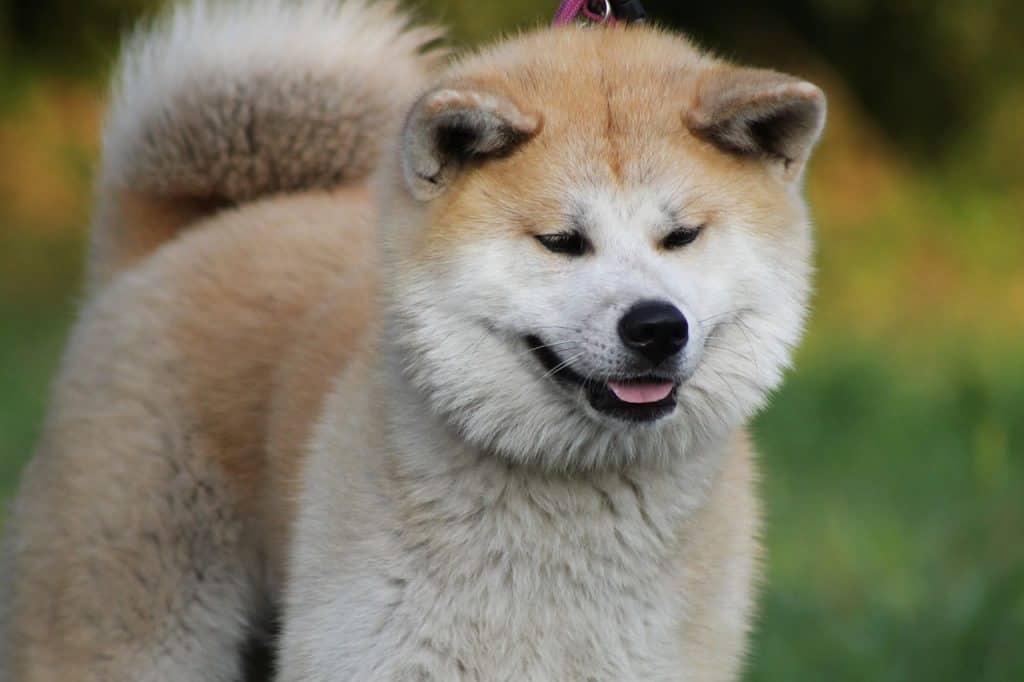
Socialization is an important part of an Akita Inu’s early development and which applies to both people and animals.
It is an integral part of how Akitas are able to form relationships successfully.
Socializing with People
By far, this is the most important relationship any Akita will have in its life.
By people, this could be anyone ranging from your parents, friends, neighbors, your veterinarian, or pet store staff.
So, it is important to introduce your dog to these sorts of people as often as possible.
Over time, as your dog gets used to seeing these familiar faces more and more, you should allow these people to pet and touch your Akita.
Not only does this allow the Akita to get used to this kind of handling, but it increases its trust levels in people and reinforces better relationships.
Socializing with Kids
As we mentioned earlier, if you have young kids then this IS NOT the breed for you.
For older kids, they should socialize with your Akita while they are a puppy so your dog can get familiar with them and learn to love them as part of their pack.
However, adults should ALWAYS supervise and look over what goes on between the Akita and kids.
This is to ensure that the kid does not unintentionally harm the Akita in any appropriate way, such as touching the eyes or ears, etc.
Doing so would potentially result in the dog lashing out at the kid as a way of self-defense.
Socializing with Cats
The relationship between Akita Inus and cats is a volatile one, owing to the Akita’s original role as a hunting dog and the fact that this particular heritage still flows through its veins in their prey drive.
Akita Inus will learn to tolerate living with family cats, but if they see stray cats roaming around the house property, it will not hesitate to attack it.
This trait is so dominant in some Akitas that it is best not them unsupervised with family cats.
The only potentially safe option would be to raise an Akita puppy and cat together.
However, as we mentioned above it is best to avoid bringing an Akita Inu into a household with a cat.
Socializing with Dogs
Akita Inus, in general, can be dominant and dog-aggressive. This is especially true if they are of the same gender.
As same as with cats, the best scenario for this would be to raise two Akita puppies together.
You may even have less chance of aggression between the two if they are of different genders and very similar in size.
In order to phase out any of the more common aggression issues, early spaying and neutering of both dogs may be something you should discuss with a veterinarian.
All these factors may help to lessen the impact of your Akita’s aggression.
How to Care for The Akita Inu
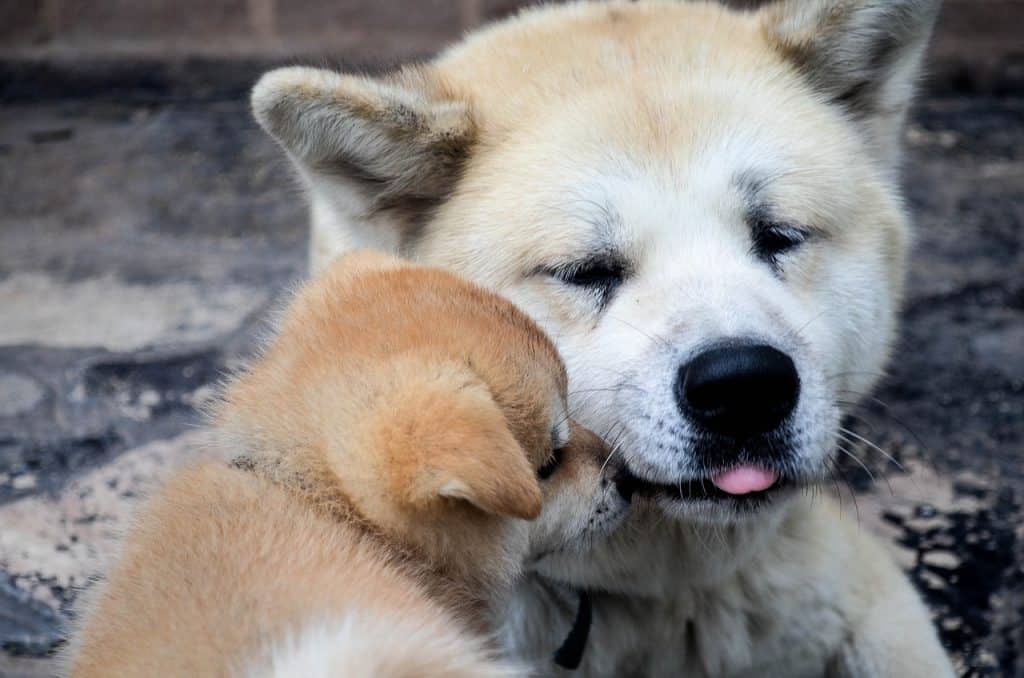
Daily Care
How Much Exercise Does My Akita Inu Need?
Akita Inus do not need a great deal of exercise. Generally, 1 hour of exercise each day should be enough to fulfill their needs.
This could take the form of a brisk walk, a run, or even playing in the backyard or the dog park.
Over-exercising your Akita could result in them becoming bored with the activity which is very common among this breed.
Feeding Requirements
Feeding requirements for Akita Inus can differ by age, gender, and size.
So, it is recommended to talk to your veterinarian to get an idea of an appropriate feeding schedule for Akita dog or puppy.
Giving them high-quality dog food or even home-prepared dog food (whatever is supervised and approved by your veterinarian) is recommended for your Akita.
These dogs should be fed twice a day. One meal in the morning and one meal in the evening is generally preferred.
It should be noted that giving your Akita to many dog treats can lead to them being overweight. So, it is best to keep watch over your dog’s calorie intake and weight level.
Lastly, it should be noted that Akita Inus can be very possessive of their food, so it is best to leave them alone while they are eating.
Overall, talk to your veterinarian and they will give you the best advice on all things related to food requirements.
Grooming
Grooming your Akita encompasses many different tasks and research should be done in regards to buying the best high-quality items to carry out each task successfully.
How Often Should You Trim An Akita Inu’s Nails?
Typically, nails should be trimmed every 4-6 weeks.
Trimming your Akita’s nails should be a regular occurrence. If not done, this can result in overly long nails which can cause pain and other issues for the dog.
Care should be taken to ensure that they are cut at an appropriate length and not too much has been taken off.
An easy way to tell that your Akita needs their nails trimmed is if your Akita walks on a hard surface, and you hear a ‘click’ sound, then they should be trimmed.
How Often Should You Brush Your Akita Inu’s Teeth?
Brushing your dog’s teeth 2-3 times per week is a must to ensure good dental health.
Avoiding this could result in dental problems and hygiene issues in the long term.
It is important to avoid using human toothpaste as this can be harmful to your dog. Instead, it is recommended to use canine toothpaste, which can be found in pet stores.
How Often Should You Bathe An Akita Inu?
According to Petco, a good routine to follow is bathing your dog every four weeks.
Although, the frequency may vary depending on the activity, seasons, and how often your dog gets dirty.
The reason why you don’t want to bathe your dog too often is that you may deprive them of the protective oils on their coat which can lead to irritation.
However, not bathing them enough can lead to the buildup of bad things on their coat that if left unattended can create skin conditions and other problems.
Of course, you won’t want your Akita to smell bad either.
Another bathing-related thing to be mindful of is which shampoo you are using.
It is best to buy a product that is Akita specific in terms of breed or even for a specific coat type.
Natural shampoos tend to be sought out as they do not damage the protective oils on your dog’s hair.
Also, if the owner chooses, a hydrating conditioner can be used as well to leave your Akita smelling clean and looking moisturized. Again, this should be dog-specific.
How Often Should You Brush An Akita Inu?
Akita Inus will need to be brushed generally once a week to remove any dead hairs.
However, during Spring and Fall, which is called shedding season is when shedding becomes most frequent.
During this period, brushing your Akita 2-3 times per week is considered acceptable.
It should be noted that you should brush in the direction of hair growth, not just anywhere.
There is a chance that you will find clumps of hair around the house, which means that your dog is in need of brushing.
The hair is inevitable, so it is best that you grab yourself a good vacuum now so you can clean it all up during those heavy shedding seasons.
Common Health Problems In Akita Inus
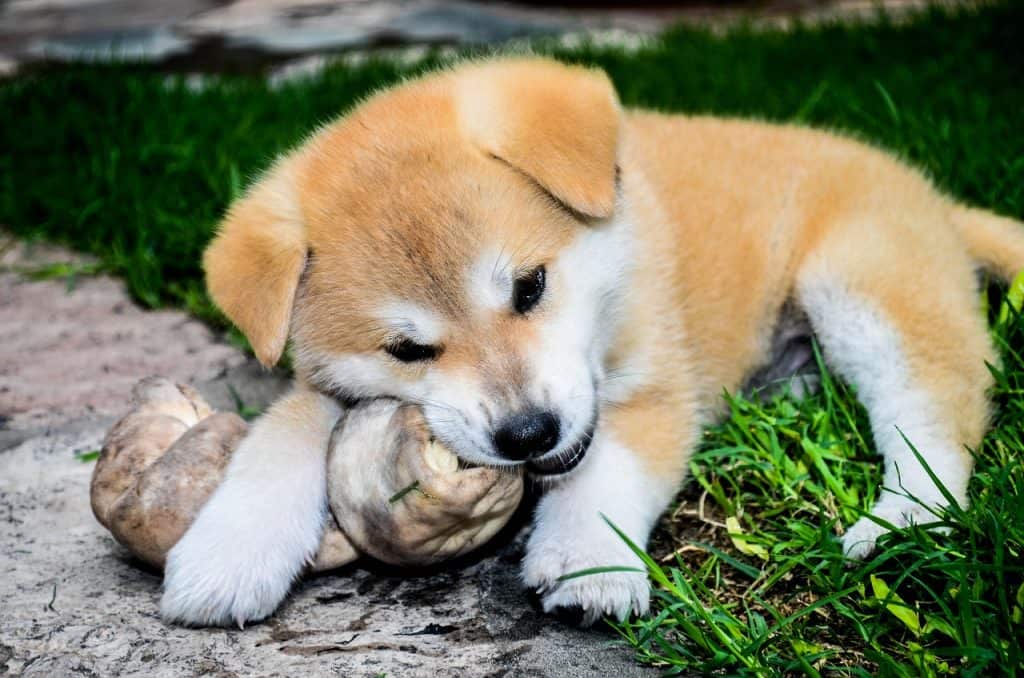
In this section, I will list out some of the most common health problems that Akita Inus face today.
Hip Dysplasia
Hip dysplasia usually occurs when there is a deformity of the hip during growth. It is usually the most common form of health problem for Akitas.
Elbow dysplasia also has a habit of occurring within this breed. However, none of these conditions are life-threatening to your Akita Inu.
Symptoms to look out for to know if your dog has hip dysplasia or even elbow dysplasia include stiffness and loss of motion in the limbs and pain.
Progression of either of these health problems can lead to arthritis developing in the affected joint and usually worsens as the dog gets older.
However, there is medication to treat all of us, which includes using corticosteroids, non-steroid types of arthritis medication combined with pain management, dietary supplements, and hydrotherapy.
More information can be seen here.
Hypothyroidism
Hypothyroidism is when a certain gland makes doesn’t make enough of a hormone called thyroxine that control metabolism.
This leads to things like hair loss, weight gain, muscle loss, ear infections, heat problems, seizures and other problems.
Since this is a relatively common problem among many dog breeds there are relatively easy ways to treat it using oral drugs.
Treatments for this disorder can be seen here.
Progressive Retinal Atrophy (PRA)
Akita Inus are prone to PRA which is a eye disease that gradually makes your dog blind through the deterioration of the retina.
It starts with blindness in the night, or night-blind, then as it gets worse they will lose their vision during the day time.
Surprisingly dogs that are affected tend to adapt well to their loss of vision, however, you should try to keep their environment the same as learning all new surroundings with limited vision will be a challenge.
Even moving things around the house may hurt your dog’s ability to navigate the environment.
This is a hereditary disease so be sure to get health information from a breeder before buying to see what your dog may be at risk for.
More information can be seen here.
Pemphigus Foliaceus
This is a serious skin condition that can affect some Akitas. Another autoimmune disease, the compound, which holds skin cells together, is attacked by the body.
Symptoms of this disease include blisters and lesions, which can be seen on the skin. This can result in secondary infection problems and a decline in the Akita Inu’s health.
Chemotherapy and drug therapies can be used to treat this disease.
More information can be seen here.
Bloat
Bloat is caused when a dog’s stomach becomes twisted at both ends. As a result, this can block the escape of gas, liquid, and other stomach contents from the stomach.
As a result, it causes the dog’s stomach to expand like a balloon.
Symptoms to look out for include a bloated abdomen, unproductive retching, pacing and restlessness, excessive saliva, standing with elbows pointed outward and neck extended, fast heavy or otherwise difficult breathing, rapid heart, and pulse rate, pale mucus membranes and prolonged capillary refill time and finally, collapsing.
Unfortunately, there is no treatment or cure for this condition. However, it is advisable to get to the vet as soon as possible for surgery.
More can be read here.
How To Buy An Akita Inu
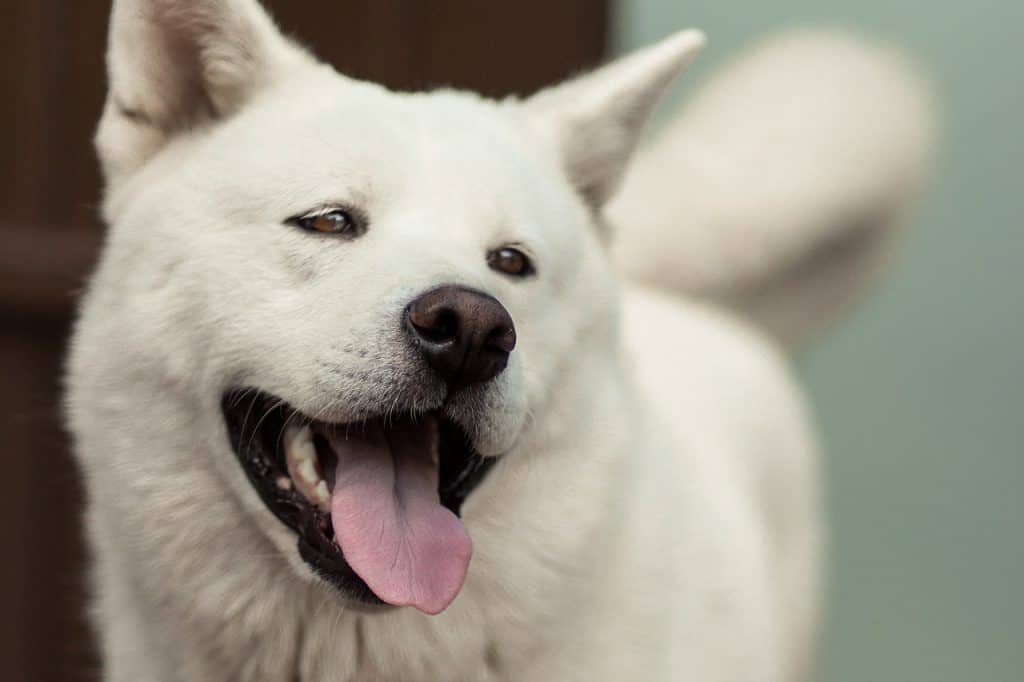
Many people choose to get Akita Inus from either a breeder or a shelter.
Although both methods are fine, there are some things that set them apart.
How Much Do Akita Inus Cost?
Although the cost of Akita Inus can go all the way up to $6,500 and beyond you can get many for between $1,500 to $3,500.
They are actually on our list of the most expensive dogs.
And if you do see a breeder that is selling an Akita for less than $500 don’t buy from them as they are most likely untrustworthy or irresponsible.
Buying from bad breeders can lead to you getting a dog that has been bred poorly with several health issues that will cost you a lot of money down the line.
For a fantastic list of questions to ask breeders check out this resource.
Some things that can impact the price are things like pedigree, the parents of the dog, the size of the dog, the availability of the dog, whether the dog is purebred or not, where the dog comes from, and if the dog is show-quality.
Another factor that may impact price is whether or not you are getting a Japanese Akita or an American Akita.
Fun Fact: Some Akita Inus from Japan that are show-quality can cost up to $75,000!
Breeder
A great way to find a breeder online is through this helpful AKC marketplace tool.
It lists all the dogs or puppies available including all the closest ones in your local area.
Plus, it lets you get in contact with them. There are several advantages to choosing a breeder:
There are common health-related problems that are passed down from breed to breed.
However, with a breeder providing genetic health testing, it means that your new puppy will unlikely carry any of these health defects.
You get a chance to see what environment the puppy grows up in which you can preserve in your own home.
By seeing all the breeds, you can choose what is the right one for you.
Shelter
There is likely to be a shelter dog organization in your local area. There are Facebook pages, apps, and websites that contain all this information.
So, it’s best to find what is best for you. There are some advantages to choosing a shelter dog:
Most dogs from shelters will have been neutered, potty-trained, and trained on how to behave, saving you the time.
You will be told about the dog’s personality, so you will know how to treat them right.
The love and gratitude shown from the dog will be unlike any other as it gets to know its new owner.
Just make sure you read about the dog’s history to make sure they don’t have any trauma that make be incompatible with your living situation.
Getting Started With An Akita Inu
Hacks and Tips for New Owners:
Although, we definitely do not recommend that you get an Akita if you just starting off as a dog owner, here are some tips if you decide otherwise.
Here are 10 tips for anyone looking to get an Akita puppy.
- Discuss with your veterinarian what dog food your Akita needs.
- Designate a part of your home where your puppy can sleep.
- Although your dog may be housetrained, assume they are not, and reward them for good behavior.
- Your dog should be limited to how much of the house they can access.
- To make them feel relaxed, give your dog their own room.
- Dogs do not like change. So, once you come up with a routine, stick with it.
- Try to create a calming environment at all times.
- Remember to be patient. Looking after dogs is not easy.
- If your dog won’t eat, try to add some variety to their diet.
- If you are not sure about how to deal with your dog’s behavioral issue, hire a dog trainer or dog behavior consultant.
Conclusion
Now that we have reached the conclusion, it is time to finish off this article. There are lots of things to consider if deciding to get this dog or not.
However, talking with Akita owners, veterinarians and general experts in this particular breed will offer their own opinion on whether this breed is the right dog for you.
Although the first few weeks of getting an Akita Inu may seem difficult at first, it is important to remember that if treated right, they will perhaps be your best friend for life.
References
https://www.thepaws.net/7-celebrities-who-own-akita-inus/
https://www.akc.org/dog-breeds/akita/
https://wagwalking.com/training/obedience-train-an-akita
https://www.veterinarypracticenews.com/how-many-vet-visits-does-a-puppy-need/
https://positively.com/dog-behavior/new-dogs/shelter-vs-breeder/
https://petcentral.chewy.com/10-tips-for-first-time-dog-owners-bringing-a-new-dog-home/
